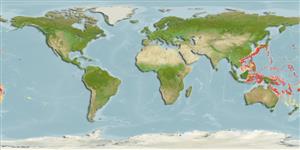Environment: milieu / climate zone / depth range / distribution range
Écologie
marin démersal; profondeur 148 - 956 m (Ref. 116586). Tropical
Disjunct distribution: Northwestern Pacific off southern Japan, Taiwan and the northern Philippines and Southwestern Pacific from the Coral Sea to Vanuatu; none from the tropical low latitudes.
Taille / Poids / Âge
Maturity: Lm ? range ? - ? cm
Max length : 11.0 cm SL mâle / non sexé; (Ref. 116586)
Description synthétique
Clés d'identification | Morphologie | Morphométrie
Épines anales: 3; Rayons mous anaux: 6. This deep-bodied species is distinguished by the following characters: convex dorsal head profile; A III + 6 in >6.5 cm SL specimens; pectoral-fin rays 16-18 with length 21.5-27% SL; gill rakers 15-18; pseudobranchial filaments 16-23, increasing with size; first anal-fin pterygiophore is long, slightly forward bent, with very broad tip and hollow; ectopterygoid with a single row of denticles; orbit diameter 11.7-13.3% SL; otolith compressed (OL:OH = 1.45-1.55) (Ref. 116586).
Found on the continental slope (Ref. 75154).
Life cycle and mating behavior
Maturité | Reproduction | Frai | Œufs | Fécondité | Larves
Schwarzhans, W.W. and A.M. Prokofiev, 2017. Reappraisal of Synagrops, Günther, 1887 with rehabilitation and revision of Parascombrops Alcock, 1889 including description of seven new species and two new genera (Perciformes: Acropomatidae). Zootaxa 4260(1):1-74. (Ref. 116586)
Statut dans la liste rouge de l'IUCN (Ref. 130435: Version 2024-2)
Menace pour l'homme
Harmless
Utilisations par l'homme
Outils
Articles particuliers
Télécharger en XML
Sources Internet
Estimates based on models
Preferred temperature (Ref.
123201): 15.3 - 26.8, mean 22.3 °C (based on 220 cells).
Phylogenetic diversity index (Ref.
82804): PD
50 = 0.5001 [Uniqueness, from 0.5 = low to 2.0 = high].
Bayesian length-weight: a=0.00977 (0.00436 - 0.02192), b=3.01 (2.81 - 3.21), in cm total length, based on LWR estimates for this (Sub)family-body shape (Ref.
93245).
Niveau trophique (Ref.
69278): 3.5 ±0.5 se; based on size and trophs of closest relatives
Fishing Vulnerability (Ref.
59153): Low vulnerability (10 of 100).
